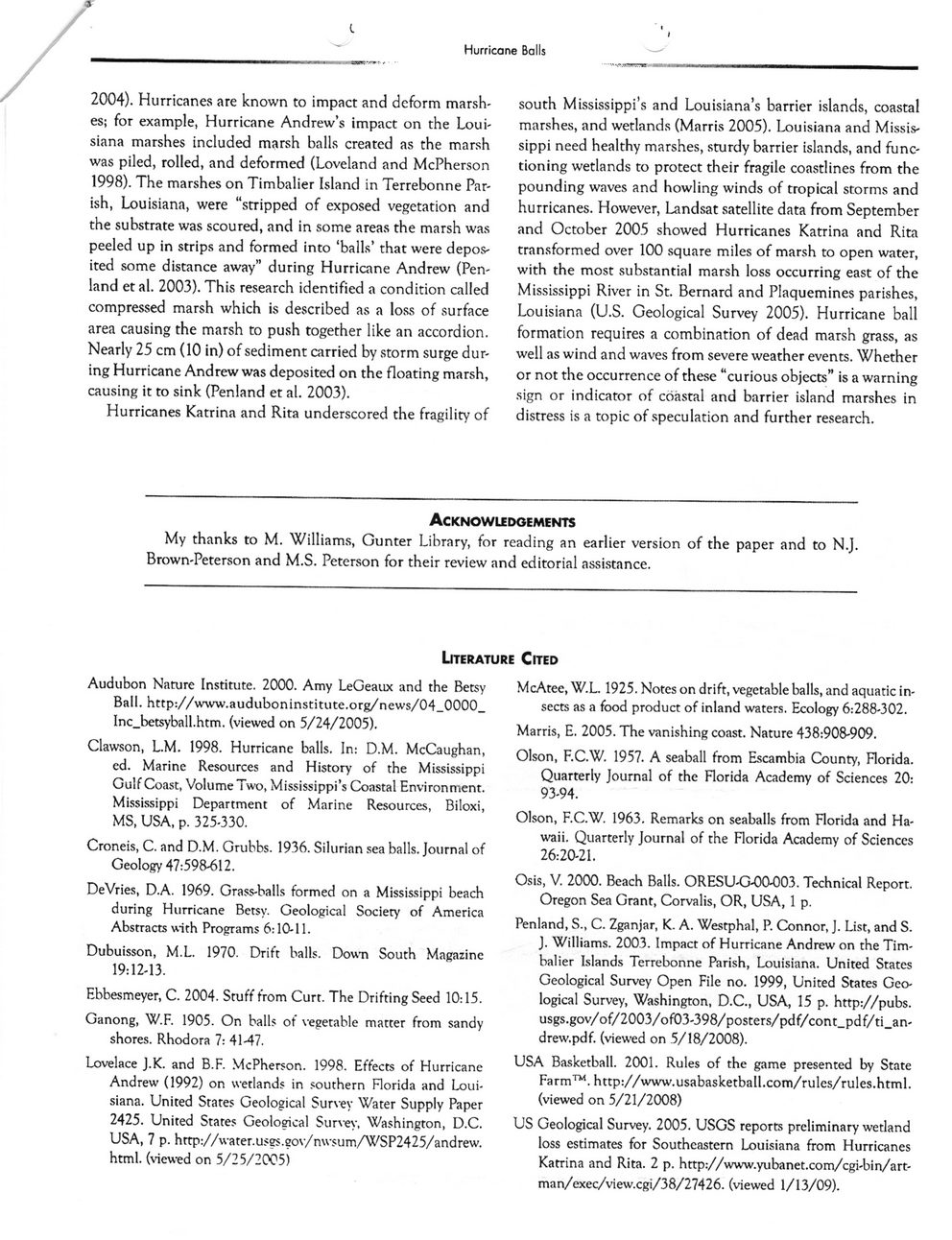This text was obtained via automated optical character recognition.
It has not been edited and may therefore contain several errors.
t Hurricane Balls 2004). Hurricanes are known to impact and deform marshes; for example, Hurricane Andrew’s impact on the Louisiana marshes included marsh balls created as the marsh was piled, rolled, and deformed (Loveland and McPherson 1998). The marshes on Timbalier Island in Terrebonne Parish, Louisiana, were “stripped of exposed vegetation and the substrate was scoured, and in some areas the marsh was peeled up in strips and formed into ‘balls’ that were deposited some distance away” during Hurricane Andrew (Pen-land et al. 2003). This research identified a condition called compressed marsh which is described as a loss of surface area causing the marsh to push together like an accordion. Nearly 25 cm (10 in) of sediment carried by storm surge during Hurricane Andrew was deposited on the floating marsh, causing it to sink (Penland et al. 2003). Hurricanes Katrina and Rita underscored the fragility of south Mississippi’s and Louisiana’s barrier islands, coastal marshes, and wetlands (Marris 2005). Louisiana and Mississippi need healthy marshes, sturdy barrier islands, and functioning wetlands to protect their fragile coastlines from the pounding waves and howling winds of tropical storms and hurricanes. However, Landsat satellite data from September and October 2005 showed Hurricanes Katrina and Rita transformed over 100 square miles of marsh to open wateT, with the most substantial marsh loss occurring east of the Mississippi River in St. Bernard and Plaquemines parishes, Louisiana (U.S. Geological Survey 2005). Hurricane ball formation requires a combination of dead marsh grass, as well as wind and waves from severe weather events. Whether or not the occurrence of these “curious objects" is a warning sign or indicator of coastal and barrier island marshes in distress is a topic of speculation and further research. Acknowledgements My thanks to M. Williams, Gunter Library, for reading an earlier version of the paper and to N.J. Brown-Peterson and M.S. Peterson for their review and editorial assistance. Literature Cited Audubon Nature Institute. 2000. Amy LeGeaux and the Betsy Ball, http://www.auduboninstitute.org/news/04_0000_ Inc_betsyball.htm. (viewed on 5/24/2005). Clawson, L.M. 1998. Hurricane balls. In: D.M. McCaughan, ed. Marine Resources and History of the Mississippi Gulf Coast, Volume Two, Mississippi’s Coastal Environment. Mississippi Department of Marine Resources, Biloxi, MS, USA, p. 325-330. Croneis, C. and D.M. Grubbs. 1936. Silurian sea balls. Journal of Geology 47:598-612. DeVries, D.A. 1969. Grass-balls formed on a Mississippi beach during Hurricane Betsy. Geological Society of America Abstracts with Programs 6:10-11. Dubuisson, M.L. 1970. Drift balls. Down South Magazine 19:12-13. Ebbesmeyer, C. 2004. Stuff from Curt. The Drifting Seed 10:15. Ganong, W.F. 1905. On balls of vegetable matter from sandy shores. Rhodora 7: 41-47. Lovelace J.K. and B.F. McPherson. 1998. Effects of Hurricane Andrew (1992) on wetlands in southern Florida and Louisiana. United States Geological Survey Water Supply Paper 2425. United States Geological Survey, Washington, D.C. USA, 7 p. http://water.usss.gov/nwsum/WSP2425/andrew. html. (viewed on 5/25/2005) McAtee, W.L. 1925. Notes on drift, vegetable balls, and aquatic insects as a food product of inland waters. Ecology 6:288-302. Marris, E. 2005. The vanishing coast. Nature 438:908-909. Olson, F.C.W. 1957. A seaball from Escambia County, Florida. Quarterly Journal of the Florida Academy of Sciences 20: 93-94. Olson, F.C.W. 1963. Remarks on seaballs from Florida and Hawaii. Quarterly Journal of the Florida Academy of Sciences 26:20-21. Osis, V. 2000. Beach Balls. ORESU-G-00-003. Technical Report. Oregon Sea Grant, Corvalis, OR, USA, 1 p. Penland, S., C. Zganjar, K. A. Westphal, P. Connor, J. List, and S. J. Williams. 2003. Impact of Hurricane Andrew on the Timbalier Islands Terrebonne Parish, Louisiana. United States Geological Survey Open File no. 1999, United States Geological Survey, Washington, D.C., USA, 15 p. http://pubs. usgs.gov/of/2003/of03-398/posters/pdf/cont_pdf/ti_an-drew.pdf. (viewed on 5/18/2008). USA Basketball. 2001. Rules of the game presented by State Farm™, http://www.usabasketball.com/rules/rules.html. (viewed on 5/21/2008) US Geological Survey. 2005. USGS reports preliminary wetland loss estimates for Southeastern Louisiana from Hurricanes Katrina and Rita. 2 p. http://www.yubanet.com/cgi-bin/art-man/exec/view.cgi/38/27426. (viewed 1/13/09).

Hurricane Balls Gulf-and-Carribbean-Research-(3)